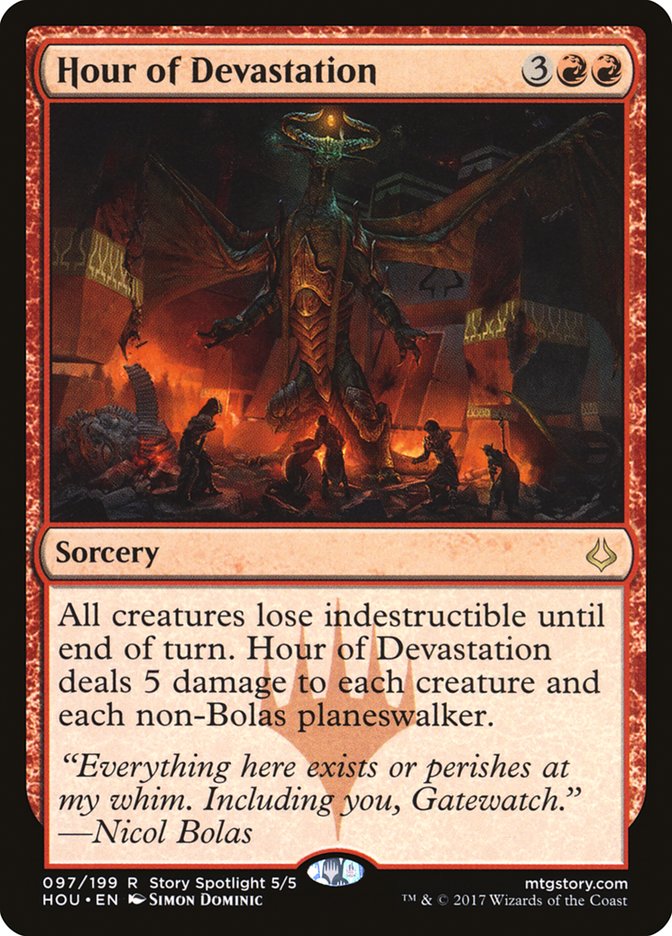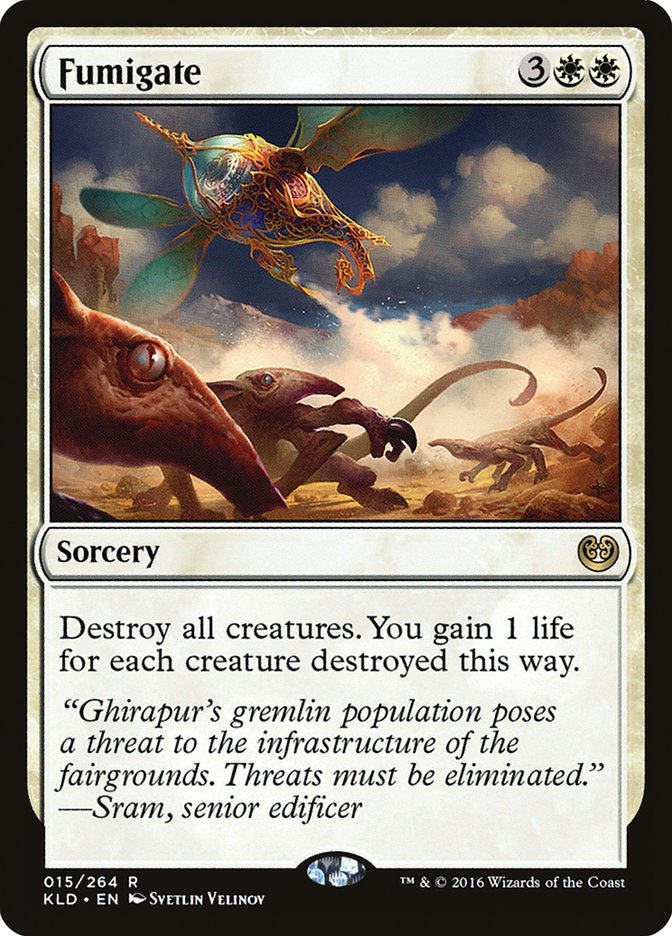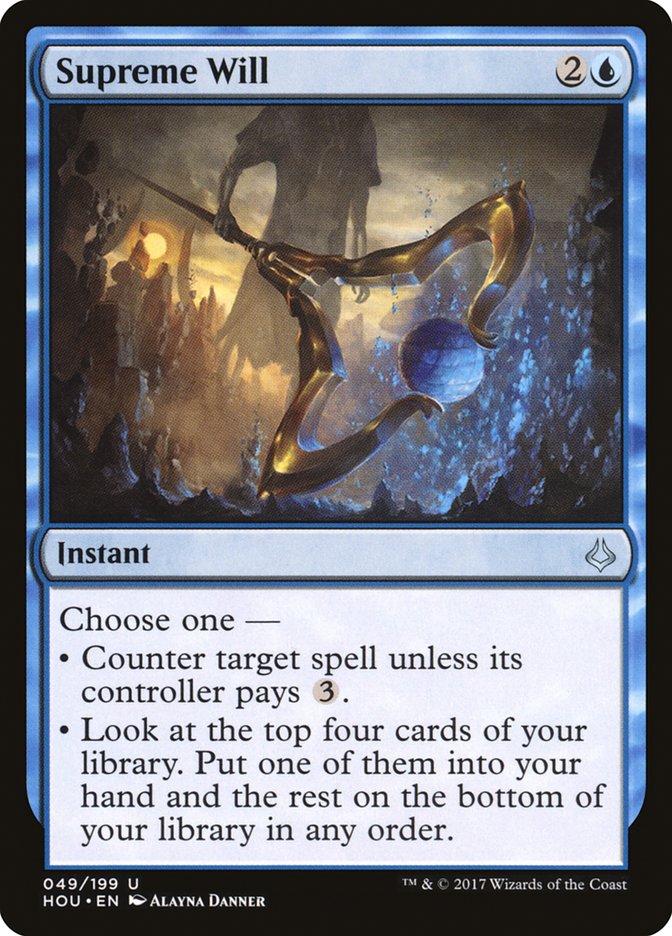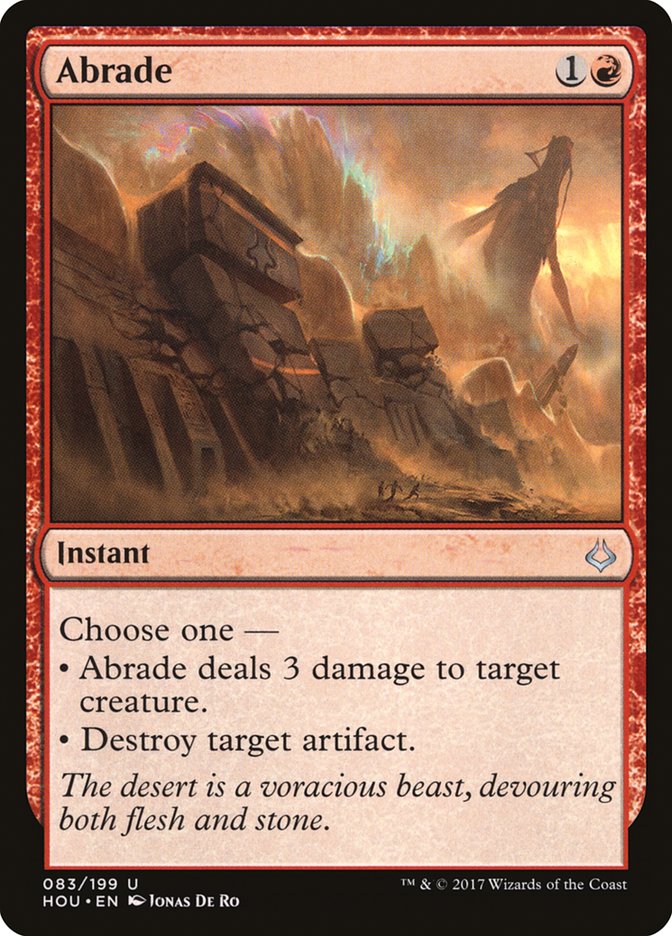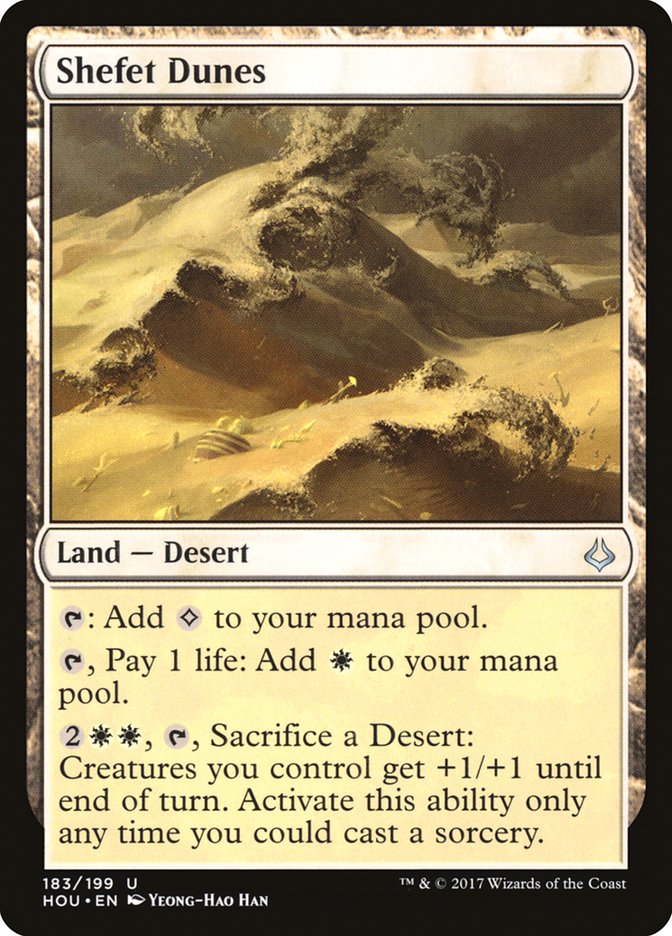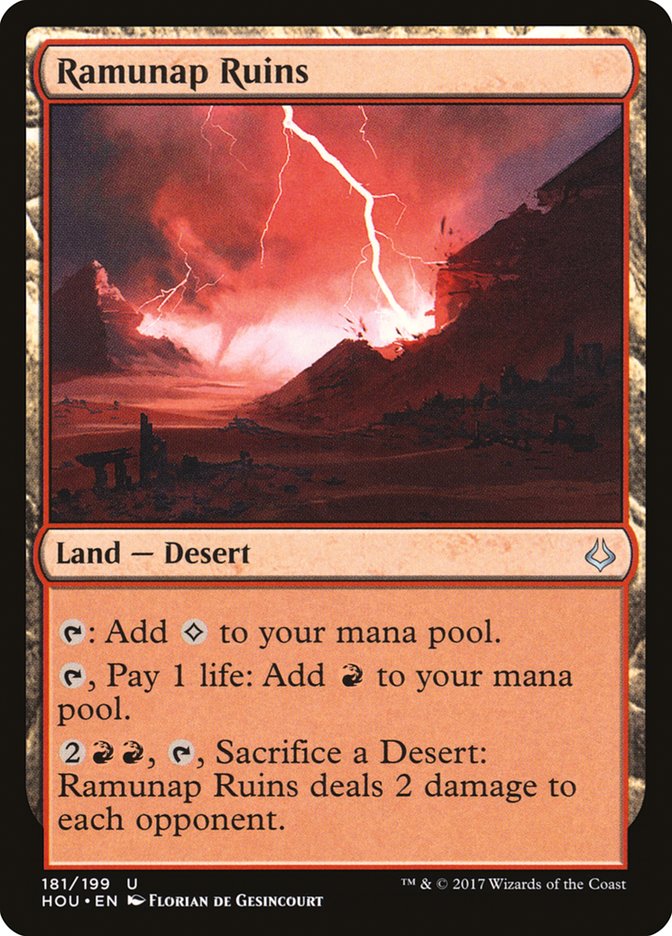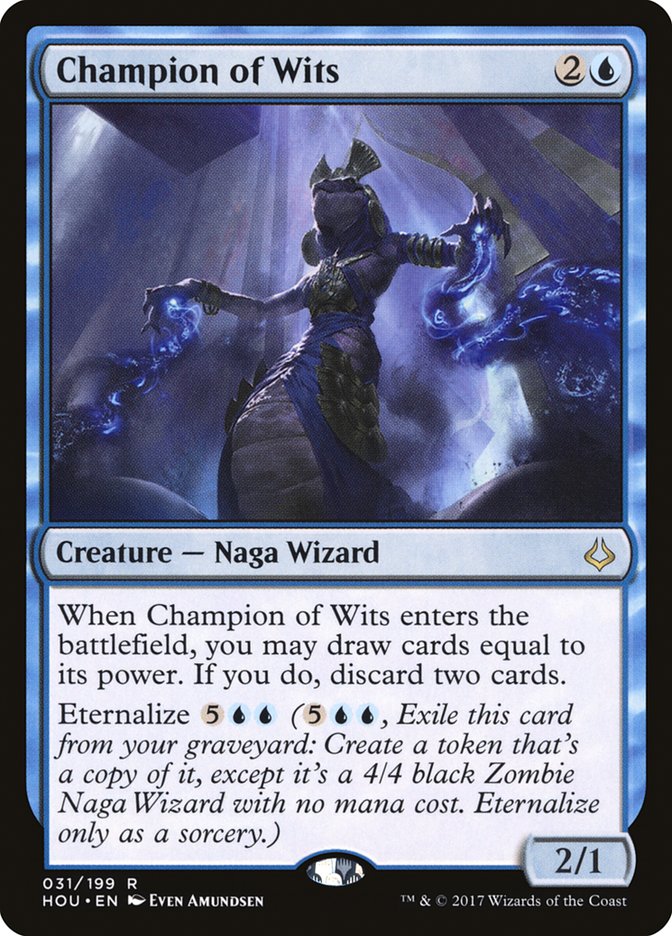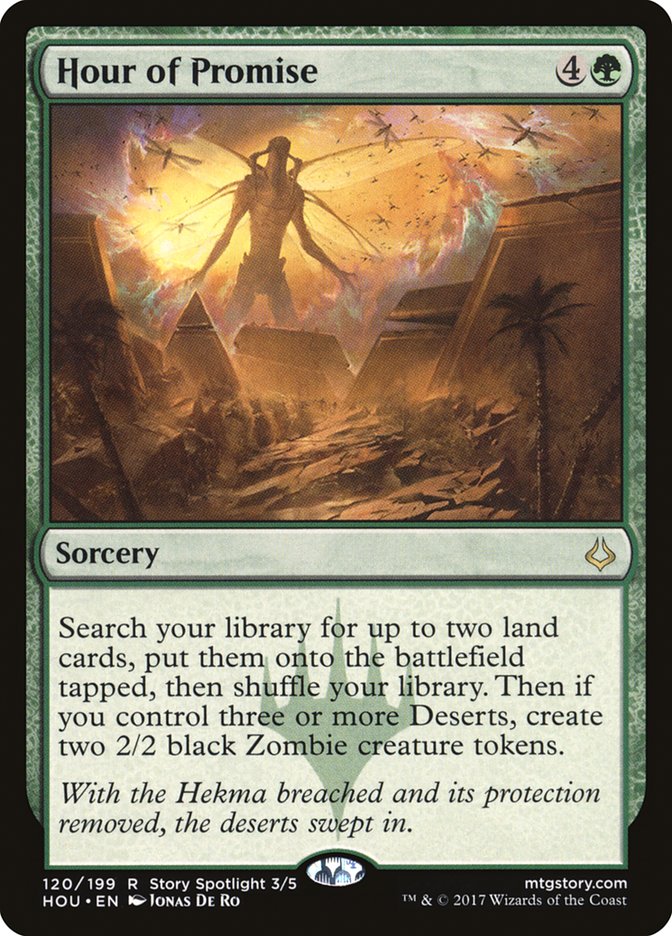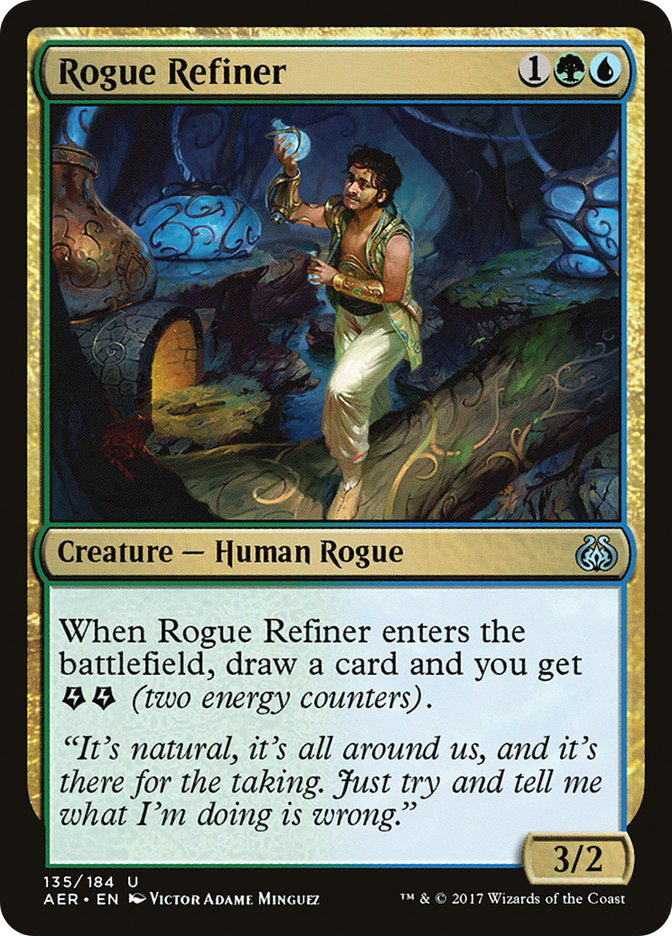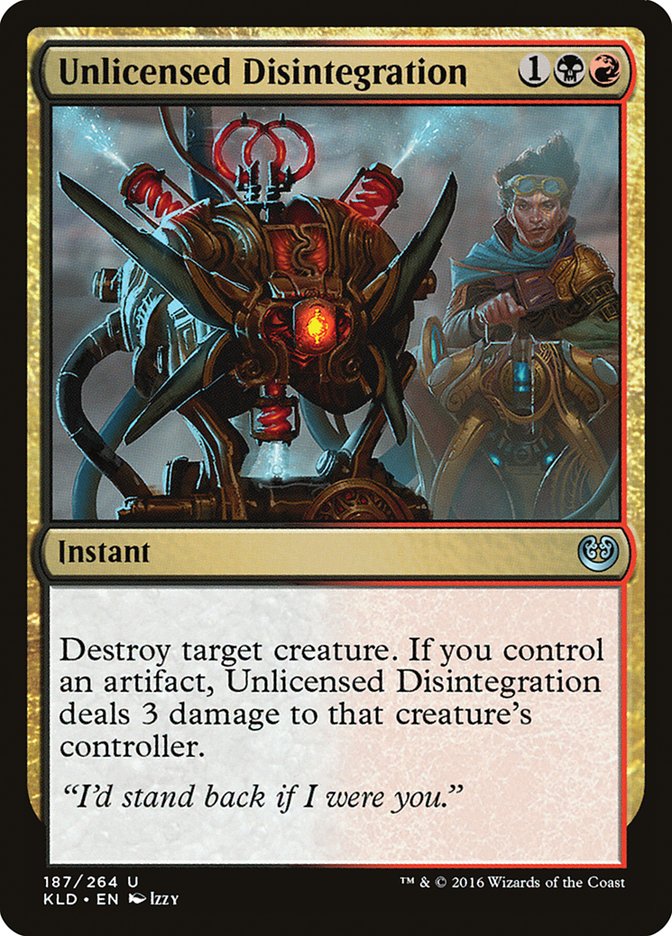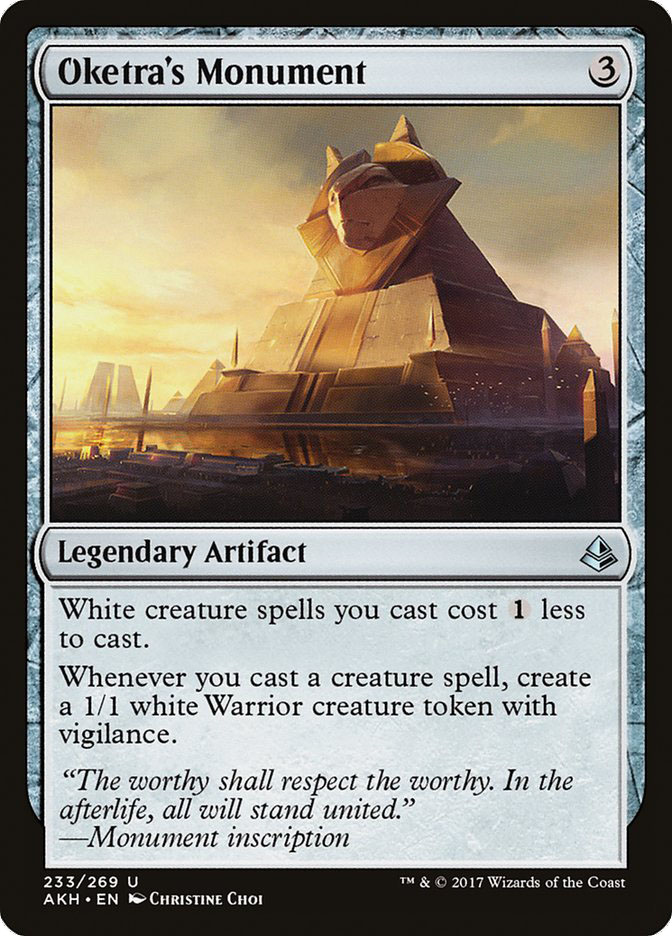Hour of Devastation did the impossible: it got me to switch off B/G Energy.
Sorry, old friend.
When I started testing Hour of Devastation Standard for #SCGCIN, I fully expected that I would end up playing B/G Energy at the event. After all, I did win a tournament with it just two weeks ago. But time changes all things, and instead of happily battling my way through the tournament with B/G Energy, I found myself playing W/U Monument and losing a Round 15 win-and-in to B/G instead. Ho-hum.
So, what was it about Hour of Devastation that got me to not play one of my all-time favorite decks and instead pilot its natural prey?
Let’s start at the beginning.
An Ever-Changing Rock-Paper-Scissors
The first thing I always do when seeking to understand how the printing of a new set will affect a Standard format is to look at what each of the best decks from before gain from it. In my mind, prior to Hour of Devastation, Standard had six good decks: B/G Energy, U/R Control, U/W Monument, Zombies, Mardu Vehicles, and Temur Energy. Most of these decks had a coupleof variants and there were certainly other playable decks, but you could expect around 90% of players to be on one of those six decks.
Very early on in testing, we identified that U/R Control was the big winner from Hour of Devastation (and from Hour of Devastation).
I wrote this card off at first as simply another five-mana sweeper, and probably one worse than Fumigate at that. The fact that it hit planeswalkers was enticing, but not enough to sell me on it. Still, it was enough to get me to play some games with an updated U/R Control deck.
Turns out, thinking of Hour of Devastation as another five-mana sweeper was a huge mistake. Hour of Devastation isn’t a slightly-worse or a slightly-better Fumigate; it’s a red Fumigate.
Previously, every controlling Torrential Gearhulk color combination had a glaring weakness. U/R Control lacked a way to catch up from a battlefield gone out of control in a way that Sweltering Suns couldn’t fix, which happened fairly often. U/W Control had access to Fumigate, but its spot removal was so bad that opposing strategies could force the sweeper by deploying only minimal pressure and then rebuild. Jeskai Control had access to all the necessary tools, but lost to its own manabase too often for comfort. Yet with Hour of Devastation, the hole in the U/R Control boat was plugged.
From the perspective of the B/G Energy deck I played at the Roanoke Classic, Hour of Devastation is a nightmare. B/G Energy beat U/R Control most commonly in one of two ways. Either it found a way to present a wide battlefield of four- or five-toughness creatures or it used the threat of Nissa, Voice of Zendikar’s ultimate to force the U/R deck to play a game it didn’t want it to play. The common thread of these two plans, as far as I can see, is that Hour of Devastation shuts them both down.
Of course, Hour of Devastation isn’t just good against B/G Energy. How is Mardu Vehicles supposed to leverage playing four copies of Gideon, Ally of Zendikar against a control deck that can just Hour of Devastation planeswalkers away? Trust me; it’s much easier for Temur Energy to build Longtusk Cubs and Bristling Hydras to four toughness to get out of Sweltering Suns range than it is to build them to six toughness to protect from Hour of Devastation. The number of lord effects Zombies needs to get to six toughness is not at all realistic. That’s not to say that none of these decks can beat U/R Control with Hour of Devastation, just that the dynamics of these matchups were all changed by the card, and all in the favor of U/R Control.
Nothing else from Hour of Devastation was poised to be as impactful on existing matchups as Hour of Devastation, but a candle shouldn’t be ashamed of not shining as bright as the sun. The Shefet Dunes cycle of Desert spell-lands were almost all good, with Shefet Dunes in W/U Monument being probably the best Desert / existing deck pairing. Abrade proved to be excellent across the whole spectrum of red decks, providing an easy answer to Oketra’s Monument and Torrential Gearhulk on a card that still killed Winding Constrictor and Longtusk Cub (most of the time).
Bold New Archetypes
But understanding how the new cards looked to change the intra-“Tier 1” dynamics was only one piece of the puzzle. Whenever new cards enter a Standard format, there’s always the possibility that some new deck will take the field by storm. If you’re a brewer, your goal is to find such a deck and perfect it. If, like me, brewing isn’t really your jam, your goal is to have an idea of what kind of things could exist, and be ready for them. From least likely to most likely, here are the three potential new archetypes that were on my radar.
All of the Desert spell-lands are great at casting Thought-Knot Seer and Reality Smasher, but given the aggressive nature of the medium-level Eldrazi, the red one is probably the most likely to be played alongside these powerful colorless cards. These lands put the idea of aggro-midrange Eldrazi decks in my head, and I knew that was a style of deck I wanted to have game against.
In my experience, beating Eldrazi decks like these centers around Thought-Knot Seer. If Thought-Knot Seer gets to stick around on the battlefield after taking a card from your hand, it’s very hard to win. To make this more likely, Eldrazi decks tend to play the most impactful low drops they possibly can, such as Hanweir Garrison. By forcing you to respond to the Garrison, they try to pave the way for the Thought-Knot. To win, you need to either be able to match their early-game without over-exerting yourself or be a deck that makes the body of Thought-Knot Seer not matter much.
Moving right along, in the couple of weeks before the event, there was some chatter around Champion of Wits. Gerry Thompson wrote a boldly titled article about the card and different ways to build with it, and the card showed up in the early Magic Online results. Decks that wanted to use their graveyard as a resource stood to gain a lot from an enabler that was both an early creature and a late-game source of card advantage.
The problem with preparing for Champion of Wits was that the correct build of the deck was very unclear. Some Champion of Wits decks tried to push the delirium mechanic to its limit and played Traverse the Ulvenwald and Ishkanah, Grafwidow. Other versions just updated the U/R Emerge deck and eschewed green and delirium altogether. No matter what, though, the Champion of Wits strategies hinged on Kozilek’s Return and Elder Deep-Fiend, and I prioritized having a plan against those two cards.
If there was chatter around Champion of Wits, there was outright buzz around Hour of Promise. The turn 5, turn 6 one-two punch of Hour of Promise into a Shrine of the Forsaken Gods-powered Ulamog, the Ceaseless Hunger was too obviously powerful to be ignored. Todd Anderson wrote about the G/R ramp deck a few days before #SCGCIN and cemented in my mind that ramp was a strategy I wanted to be ready for.
For every deck except the most aggressive, beating a ramp deck has to involve some disruption. Their gameplan is designed to invalidate yours, so you can’t let them do what they want to do. But you can’t overload on disruption, because you also must be able to kill them before they can just hard-cast their payoff spells. This sounds like a tightrope to walk, but against Standard ramp decks, it’s generally not that hard. The key is playing an archetype that has access to relevant interaction, because a lot of decks struggle to find cards that can profitably interact.
Levels and Monuments
All right, now you’re up to speed. The above is essentially all the information I gleaned from many hours of testing Hour of Devastation Standard. The conclusion I reached from that information was to play W/U Monument. Let’s go through the logic.
Of the old decks, U/R Control was the big winner. It gained substantial ground on B/G Energy, Temur Energy, Mardu Vehicles, and Zombies. Of the potential new decks, G/R Ramp was almost certain to be the most played. If you think back to the dark days of Aetherworks Marvel, you may recall that the Marvel decks had a good matchup against U/R Control solely on the back of hard-casting Ulamog, the Ceaseless Hunger. As such, it’s likely that a dedicated ramp strategy would also be quite favored against U/R Control.
My “Level 0” decks for this tournament were B/G Energy, Temur Energy, Mardu Vehicles, and Zombies. These decks didn’t gain anything substantial from Hour of Devastation and lost a lot of ground in an important matchup. Given the time pressures and typical dynamics of a first-week Standard Open, I still expected a substantial amount of the field to be playing these decks. I wanted to be able to compete with these decks, but I didn’t want to play one of them.
My “Level 1/2” for the event was any of the Level 0 decks, updated in a way that gave it a real plan against U/R Control. I didn’t put substantial time into this plan for any deck besides B/G Energy, but I was confident that I could build B/G Energy in a way that let it compete with U/R Control. However, I was less confident that I could do so in a way that let B/G Energy still be on reasonable footing with the rest of the field. Dedicated adherents of an archetype could take this route and find reasonable success, but the number of unknowns involved kept me searching for greener pastures.
The first deck I placed at Level 1 was U/R Control. Players who did their homework would know that U/R Control got substantially better against the Level 0 decks, and would likely still be 50-50 against a Level 1/2 pilot who came gunning for control. For a while I was considering playing U/R Control myself, but was scared off by the other deck I put on Level 1: G/R Ramp.
It seemed pretty clear that G/R Ramp had the power level necessary to compete in this Standard. Its matchups against the Level 1 decks were unknown to me, but I suspected it would be favored against B/G Energy and Temur Energy and a little behind at most against Mardu Vehicles and Zombies. Playing G/R Ramp was an absolutely reasonable choice, but I was confident all the builds I had looked at and played were substantially suboptimal.
For the purpose of getting to Day 2, beating the Level 0 decks is the most important thing. To have the best shot of winning the tournament, I wanted to beat up on the Level 1 decks. I was willing to give up some ground against the Level 0 decks to give myself the best possible shot on a potential Day 2 run.
For me, the answer to this puzzle was to play W/U Monument. Todd Anderson’s Season One Invitational write-up and my own testing experience made it clear that the U/R Control matchup was good, and it seemed apparent that we could make a Spell Queller deck good against G/R Ramp. The question mark with W/U Monument was the hypothetical prevalence of Abrade. One of the strengths of W/U Monument was that the card Oketra’s Monument was very hard for most decks to interact with, especially Game 1. Hour of Devastation changed that, but Emma Handy and I weren’t scared.
Creatures (25)
- 4 Bygone Bishop
- 4 Thraben Inspector
- 4 Hanweir Militia Captain
- 2 Thalia, Heretic Cathar
- 4 Spell Queller
- 4 Selfless Spirit
- 3 Angel of Invention
Lands (25)
Spells (10)
Sideboard

Well, maybe we were a little scared. We decided to move the list towards being less reliant on Oketra’s Monument by cutting Cloudblazer for Angel of Invention. This made the deck much worse at doing the classic over-the-top Monument things, but much better at just playing the fair aggressive-tempo role the deck is forced into when it doesn’t draw Oketra’s Monument or the Monument is destroyed. Further, it gave us a definite gameplan for the mirror in case anyone else was thinking like us.
Playing Angel of Invention was made possible by being willing to cut Dusk from the maindeck. The decks Dusk is great against are all decks I put in Level 0, so we didn’t feel like dropping Dusk was a huge concern. Dusk is also the kind of card that is worse when people know about it, and now that W/U Monument is on everyone’s radar, the card seemed worse-positioned than it was at the Season One Invitational two weeks ago.
But the card that really sold me on W/U Monument as a deck choice was Negate. If you told me going into a tournament that the decks to beat were Control and Ramp, and asked me which single card I would most like to have access to, I would tell you Negate. Ideally in an aggressive shell that could wield the Negate as a tempo weapon, which is exactly what W/U Monument does.
How did things work out? Well, losing my win-and-in knocked me down to seventeenth, and Emma took 46th. Not exactly what we were hoping for, but if we’re being honest, it was a pretty impressive showing, given that we were the only two players on our 75 in the tournament.
W/U Monument was the most-represented deck in the Day 2 metagame with thirteen copies making the second day of competition. The metagame call of W/U Monument was a resounding success, but as far as I know (and from the published lists) we were the only two without Cloudblazers. It’s very possible we got a little ahead of ourselves in fearing Abrade and Cloudblazer was the right call for #SCGCIN.
However, going forward, W/U Monument will have a target on its head. Being less reliant on Oketra’s Monument and having an edge in the mirror are looking to be good things for the next week or two, and I highly recommend giving our list a shot.



